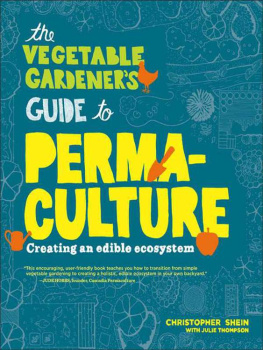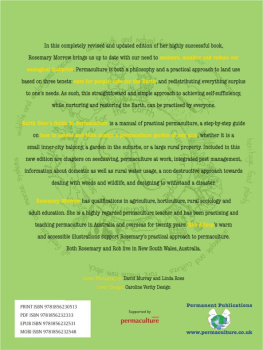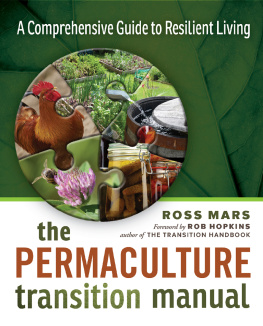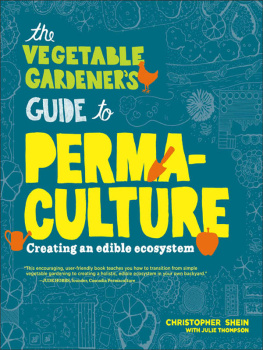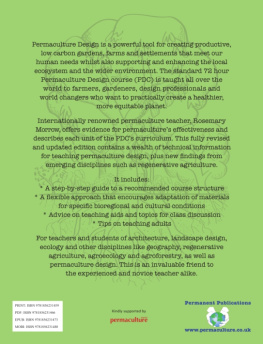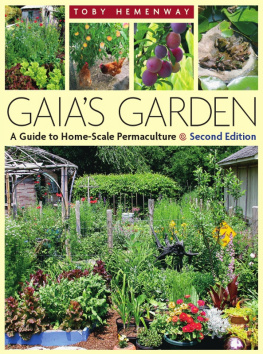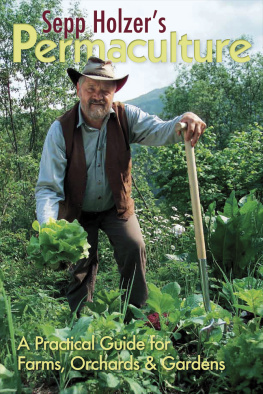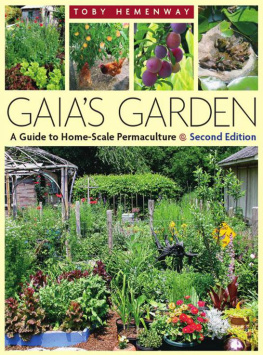
the VEGETABLE GARDENERS GUIDE to PERMACULTURE

Edible permaculture gardens are abundant polycultures, mixed plantings that occupy all available space, both vertical and horizontal.
the VEGETABLE GARDENERS GUIDE to PERMACULTURE
Creating an edible ecosystem
Christopher Shein with Julie Thompson
Timber Press
Portland London
Copyright 2013 by Christopher Shein and Julie Thompson
All rights reserved
Photo credits appear on .
Line drawings by Sonya Binnewies
The information in this book is true and complete to the best of the authors knowledge. All recommendations are made without guarantee on the part of the author or publisher. The author and publisher disclaim any liability in connection with the use of this information.
Published in 2013 by Timber Press, Inc.
The Haseltine Building
133 S.W. Second Avenue, Suite 450
Portland, Oregon 97204-3527
timberpress.com
2 The Quadrant
135 Salusbury Road
London NW6 6RJ
timberpress.co.uk
Printed in China
Book design by Laken Wright
Library of Congress Cataloging-in-Publication Data
Shein, Christopher.
The vegetable gardeners guide to permaculture : creating an edible ecosystem / Christopher Shein
with Julie Thompson. -- 1st ed.
p. cm.
Includes bibliographical references and index.
ISBN 978-1-60469-270-9
1. Permaculture. 2. Vegetable gardening. 3. Food crops. I. Thompson, Julie, 1962- II. Title.
S494.5.P47S54 2013
631.58--dc23
2012013889
A catalog record for this book is also available from the British Library.
CONTENTS
PREFACE
I first became acquainted with the Australian concept of permaculture when I was in college. Ever since then I have tried to apply its ecological gardening techniques in my various roles as a community gardener, a CSA (community supported agriculture) farmer, and a compostmeister at Linnaea Farm in British Columbia. Now I run my own permaculture landscaping business and have taught permaculture for more than ten years at Merritt College in Oakland. Ive created more than a hundred gardens, all of them inspired by permaculture principles and ethics.
Permaculture is an ancient yet cutting-edge technology. The ethics, principles, techniques, and strategies it employs are inspired by indigenous land practices around the world. My travels in Mexico and Central America and my work with the permaculture community have convinced me that we need to try to reweave the web of life into whole cloth. Permaculture not only aims to make the soil productive, but also to make enough room for everyone to come to the table and eat. My own five-year-old permaculture garden feeds me and my family every day, as well as many other friends and neighbors.
This book is a practical guide to basic ecological literacy and permaculture gardening. I have tried to break down the techniques and language of permaculture to show that any gardener can be a positive asset to the interconnected web of life. Planting a permaculture garden is a dream for many people who have even a small amount of land, and I believe that permaculture is a viable ecological design strategy suited to anyones backyardor even to a front yard, rooftop, balcony, neighbors garden, school garden, or community garden.
Making ecological gardens is about working less hard, but smarter. My favorite quote about permaculture, from Bill Mollison, is that it is thoughtful and protracted observation, not thoughtless and protracted labor. I hope this book helps you to grow your own permaculture garden, and that the experience is satisfying. Happy (permaculture) gardening.
CHRISTOPHER SHEIN
BERKELEY, CALIFORNIA

Bountiful plantings, mulched pathways, and insect-attracting perennials and shrubs create a welcoming entrance to this permaculture garden.
WHY PERMACULTURE?

Permaculture techniques can be scaled up or down to fit any size garden, from an urban balcony to a rural homestead. Fruit tree guilds, hugelkultur beds, and polyculture plantings are all essential components. Chickens help to maintain the food forest.
What Is Permaculture?
WHAT VEGETABLE GARDENER wouldnt like to grow more food in less time and for less money? Thats exactly what permaculture offers. Instead of relying on backbreaking work, fertilizers, herbicides, and pesticides, the permaculture gardener uses methods that build healthy soil, smother weeds, and promote plant life, while recycling waste products from the garden. Whether you are a beginner gardener just starting to grow your own food or an experienced grower who wants to increase your yields, youll find that permaculture offers design tools and growing techniques that will help you create an abundance of food for your family and friends while saving you effort in the garden.
Formalized in the late 1970s in Australia by Bill Mollison and David Holmgren, permaculture combines sustainable agriculture, landscape design, and ecology (the name is drawn from the terms permanent agriculture and permanent culture). It is an approach that encourages the home gardener to work with nature rather than against it to design a garden that thrives with minimal intervention. Although terms like hugelkultur , fruit tree guilds, and food forest may seem unfamiliar now, these are in fact simple concepts that can be implemented in any edible garden.
Permaculture has much in common with organic gardening, but it is a different approach. Natural ecosystems are the model, so plants are placed in mutually beneficial plant communities. There is an emphasis on perennial plants over annual ones, and permaculture gardeners grow many crops at the same time in the same location. There are ongoing recycling and re-use projects throughout the garden, such as water harvesting. And permaculture does not advocate plowing and digging the soil, but rather building it up over time with no-till methods.
Do-Nothing Farming
Masanobu Fukuoka was a major philosophical influence on the founders of permaculture. An agricultural scientist who gave up his life as a researcher to return to his family farm, Fukuoka developed a natural farming technique that he called do-nothing farming. His first question was, What can you not do? This kind of farming doesnt depend on the plow to turn over the soil, or call for the spraying of chemical fertilizers and pesticides. Instead, it relies on biological systems such as beneficial insects, cover cropping, and keeping small livestock like chickens and ducks.
In Fukuokas model, cover crops like perennial white Dutch clover are rotated with grain crops like barley, rice, and wheat. Seeds are formed into balls with clay and compost, then broadcast into the fields. After the grains are harvested, the straw is returned as mulch for the next crop. Fukuokas book, One Straw Revolution , outlines his techniques and philosophy. My favorite Fukuoka quote is, If we throw Mother Nature out the window, she comes back in the door with a pitchfork.

Next page
